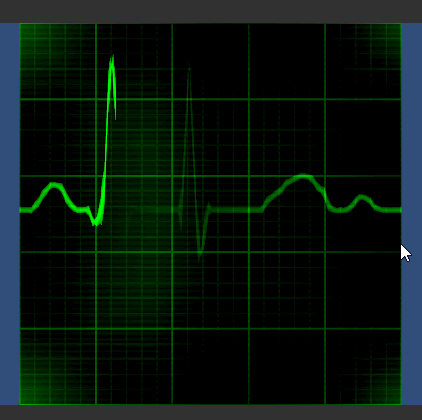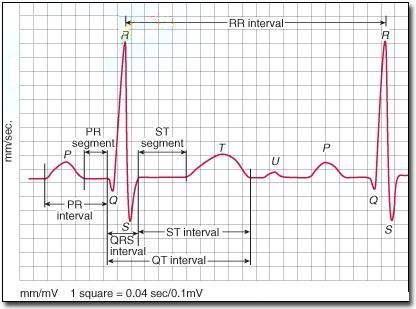效果预览
这个Shader是比赛的废案,至于为什么是废案?详见文章:2021 益游未尽 作品——《气候护卫队》
效果如下,这里演示的是正常心跳的波形循环

Shader代码
frag中的主要工作是,把所有的效果叠加(波形线条、拖尾特效、闪烁特效、格子)
Shader "Custom/ECG" {
Properties {
[Header(Color Setting)]
_backgroundColor("Background Color", Color) = (0, 0, 0, 1)
_lineColor("Line Color", Color) = (0, 1, 0, 1)
[Header(Line Setting)]
[PowerSlider(3)]
_lineWidth("Line Width", Range(0, 0.5)) = 0.02
_lightTailLength("Light Tail Length", Range(0, 2)) = 1
[Header(Grid Setting _ 1 small grid.xy equal 0.04s 0.1mV)]
_bigGridCount("Big Grid Count", vector) = (5, 5, 0, 0)
_bigGridWidth("Big Grid Width", Range(0, 1)) = 0.15
_bigGridAlpha("Big Grid Alpha", Range(0, 1)) = 1
_smallGridWidth("Small Grid Width", Range(0, 1)) = 0.2
_smallGridAlpha("Small Grid Alpha", Range(0, 1)) = 0.75
[Header(Other Setting)]
_lightPoundAlpha("Light Pound Alpha", Range(0, 1)) = 0.125
}
SubShader{
Pass {
CGPROGRAM
#pragma vertex vert
#pragma fragment frag
#include "UnityCG.cginc"
#define PI 3.14159
// 一大格所代表的量, x为时间, y为电压
#define GRID_X_SECOND (0.04 * 5)
#define GRID_Y_MV (0.1 * 5)
#define _ECG_Len 100
fixed _ECG_Arr[_ECG_Len]; // 心电图波形数据,由C#代码传入,长度固定100
struct appdata {
float4 vertex : POSITION;
fixed4 uv : TEXCOORD0;
};
struct v2f {
float4 pos : SV_POSITION;
fixed4 uv : TEXCOORD0;
};
// Color Setting
fixed4 _backgroundColor;
fixed4 _lineColor;
// Line Setting
fixed _lineWidth;
fixed _lightTailLength;
// Grid Setting
half4 _bigGridCount;
fixed _bigGridWidth;
fixed _bigGridAlpha;
fixed _smallGridWidth;
fixed _smallGridAlpha;
// Other Setting
fixed _lightPoundAlpha;
// 心跳波形
fixed HeartbeatFunc(fixed2 uv, fixed lightWidth) {
half x = uv.x * (_ECG_Len - 1); // [0, 1] => [0, len - 1]
int xl = floor(x);
int xr = (xl + 1) % _ECG_Len;
fixed y = lerp(_ECG_Arr[xl], _ECG_Arr[xr], frac(x)) / 2 + 0.5; // y值+0.5以将曲线移动到屏幕中间
return 1.0 - smoothstep(0.0, lightWidth, abs(uv.y - y));
}
// 光拖尾(按时间透明化尾部)效果
half LightFunc(fixed2 uv, half lightInterval, fixed lightTail) {
half tt = _Time[1] % lightInterval;
half lightSpeed = 1 / lightInterval;
half highlightX = tt * lightSpeed; // the leftest highlightX
half delta; // pixel distance from the first hightlightX on the right, delta~[0,1]
if (uv.x <= highlightX) {
delta = highlightX - uv.x;
} else {
delta = 1 - frac(uv.x - highlightX);
}
half light = lightTail > delta ? (lightTail - delta) : 0.0;
return light;
}
// take the screen coordinates, return the 0~1 alpha according to the pound function
// 屏幕闪烁效果
fixed PoundFunc(fixed2 uv, half lightInterval) {
half tt = (_Time[1] - uv.x * lightInterval / 2.0) % lightInterval;
half percent = tt / 0.8f; // pound lasts 0.8 seconds
return percent > 0.1 ? (-1.0 / 0.9 * (percent - 1.0)) : 0;
}
fixed TriangularWave(half x) { // => [-1, 1]
return abs(frac(x) * 2 - 1) - 0.5;
}
// take the screen coordinates, return the 0~1 alpha according to the grid function
fixed GridFunc(fixed2 uv, half2 gridXY) {
fixed scanlineX = TriangularWave(uv.x * gridXY.x) - 0.5;
fixed scanlineY = TriangularWave(uv.y * gridXY.y) - 0.5;
return max(scanlineX, scanlineY);
}
v2f vert(appdata v) {
v2f o;
o.pos = UnityObjectToClipPos(v.vertex);
o.uv = v.uv;
return o;
}
fixed4 frag(v2f i) : SV_Target {
fixed heartbeat = HeartbeatFunc(i.uv, _lineWidth);
half totalInterval = GRID_X_SECOND * _bigGridCount.x;
half light = LightFunc(i.uv, totalInterval, _lightTailLength);
fixed pound = PoundFunc(i.uv, totalInterval) * _lightPoundAlpha;
fixed bigGrid = (GridFunc(i.uv, _bigGridCount) + _bigGridWidth) * _bigGridAlpha;
fixed smallGrid = (GridFunc(i.uv, _bigGridCount * 5) + _smallGridWidth) * _smallGridAlpha;
fixed grid = max(bigGrid, smallGrid);
fixed alpha = heartbeat * light + pound;
alpha = max(alpha, grid);
fixed4 fragColor = lerp(_backgroundColor, _lineColor, alpha);
return fragColor;
}
ENDCG
}
}
}C#代码:传递波形数据给Shader
C#代码的主要工作是传入波形数据数组给Shader
using System.Collections;
using System.Collections.Generic;
using UnityEngine;
public class ECG : MonoBehaviour {
public Material material;
public Renderer renderer;
private Vector2 bigGridCount;
private float totalInterval;
private float heartRate = 0;
private int preX = 0;
private const int WAVE_ARR_LEN = 100;
private float[] wave = new float[WAVE_ARR_LEN];
// 一大格所代表的量, x为时间(s), y为电压(mV)
private const float GRID_X_SEC = 0.04f * 5;
private const float GRID_Y_MV = 0.1f * 5;
// 正常波形, 参考周期 = 0.8s, 参考峰值 = 1mV
private const float REGULAR_WAVE_REFER_T = 0.8f; // time s
private const float REGULAR_WAVE_REFER_F = 1 / REGULAR_WAVE_REFER_T * 60; // frequency bpm
private const float REGULAR_WAVE_REFER_P = 1; // peak val mV
private readonly float[] REGULAR_WAVE_ARR = { 0.025f, 0.025f, 0.025f, 0.025f, 0.022f, 0.031f, 0.058f, 0.099f, 0.133f, 0.161f, 0.181f, 0.19f, 0.191f, 0.182f, 0.163f, 0.135f, 0.102f, 0.06f, 0.032f, 0.022f, 0.025f, 0.025f, 0.029f, 0.018f, -0.023f, -0.068f, -0.037f, 0.059f, 0.255f, 0.578f, 0.983f, 1.0f, 0.498f, -0.097f, -0.273f, -0.13f, 0.002f, 0.037f, 0.025f, 0.025f, 0.025f, 0.025f, 0.025f, 0.025f, 0.025f, 0.025f, 0.025f, 0.025f, 0.025f, 0.025f, 0.025f, 0.025f, 0.025f, 0.024f, 0.032f, 0.052f, 0.078f, 0.1f, 0.12f, 0.14f, 0.159f, 0.179f, 0.196f, 0.212f, 0.225f, 0.237f, 0.246f, 0.25f, 0.248f, 0.24f, 0.225f, 0.206f, 0.184f, 0.161f, 0.134f, 0.101f, 0.06f, 0.031f, 0.022f, 0.025f, 0.025f, 0.023f, 0.03f, 0.052f, 0.082f, 0.101f, 0.111f, 0.11f, 0.098f, 0.078f, 0.06f, 0.043f, 0.031f, 0.025f, 0.025f, 0.025f, 0.025f, 0.025f, 0.025f, 0.025f };
// 插值计算波形值
float GetWaveY(float[] waveArr, float x, float peakVal) {
if (x < 0) {
x += ((-x / WAVE_ARR_LEN) + 1) * WAVE_ARR_LEN;
}
x %= WAVE_ARR_LEN;
int xl = Mathf.FloorToInt(x) % WAVE_ARR_LEN;
int xr = (xl + 1) % WAVE_ARR_LEN;
return Mathf.Lerp(waveArr[xl], waveArr[xr], x - xl) * peakVal;
}
void Start() {
// 获取必要属性
bigGridCount = material.GetVector("_bigGridCount");
totalInterval = GRID_X_SEC * bigGridCount.x; // 总时长 = 大格子时间 * 大格子数量.x
material.SetFloatArray("_ECG_Arr", wave);
renderer.material = material;
}
delegate void FillLambda(int end);
// 展示单独一种波的循环
void ShowSingleWave(float[] waveArr, float interval, float peakVal) {
// 根据shader时间获取当前扫描进度,相当于获取了x坐标
float shaderTime1 = Shader.GetGlobalVector("_Time")[1];
float scanProcess = shaderTime1 % totalInterval / totalInterval; // 值域[0, 1]
int x = (int)(scanProcess * WAVE_ARR_LEN);
// 根据波形周期计算此时波形进度
float waveProcess = (shaderTime1 % interval) / interval;
// 更新此时x位置波形数据
wave[x] = GetWaveY(waveArr, waveProcess * WAVE_ARR_LEN, peakVal);
// 补上上一帧和这一帧中间未打的点
FillLambda Fill = (int end) => {
for (; preX < end; ++preX) {
float preShaderTime1 = shaderTime1 - (totalInterval / WAVE_ARR_LEN) * (end - preX);
float preWaveProcess = (preShaderTime1 % interval) / interval;
wave[preX] = GetWaveY(waveArr, preWaveProcess * WAVE_ARR_LEN, peakVal);
}
};
Fill(x);
if (preX > x) {
Fill(WAVE_ARR_LEN);
preX = 0;
Fill(x);
}
// 赋值给shader
material.SetFloatArray("_ECG_Arr", wave);
Debug.Log("scanProcess: " + (scanProcess * 100) + "%");
}
void Update() {
ShowSingleWave(REGULAR_WAVE_ARR, REGULAR_WAVE_REFER_T, REGULAR_WAVE_REFER_P);
}
}Python代码:用于生成特定长度的波形数组
代码中的REGULAR_WAVE_ARR数组,来源于一个Python脚本
import matplotlib.pyplot as plt
import numpy as np
from scipy.signal import savgol_filter
import pyperclip
# 原始数据,用图片画格子数出来的
# 正常波形, 参考心率 = 75bpm, 参考峰值 = 1mV
# y = [0.2, 0.2, # |
# 0.2, 1.0, 1.5, 1.5, 1.0, 0.2, # P
# 0.2, 0.2, # |
# -0.8, # Q
# 2.0, 10.0, # R
# -3.0, 0.2, # S
# 0.2, 0.2, 0.2, 0.2, 0.2, 0.2, # |
# 0.2, 0.7, 1.1, 1.5, 1.8, 2.0, 1.9, 1.5, 1.0, 0.2, # T
# 0.2, # |
# 0.2, 0.8, 0.9, 0.5, 0.2, # U
# 0.2, 0.2] # |
# 房颤 = (正常 - P + f杂波) & 心律不齐, 参考心率 = 75bpm, 参考峰值 = 1mV
# f杂波频率350~600bpm, 此参考波形数据未添加杂乱和心律不齐两种特征, 请自行使用sin和rand等函数实现
y = [0.2, 0.2, # |
0.2, 0.2, 0.2, 0.2, 0.2, 0.2, # | (P)
0.2, 0.2, # |
-0.8, # Q
2.0, 10.0, # R
-3.0, 0.2, # S
0.2, 0.2, 0.2, 0.2, 0.2, 0.2, # |
0.2, 0.7, 1.1, 1.5, 1.8, 2.0, 1.9, 1.5, 1.0, 0.2, # T
0.2, # |
0.2, 0.8, 0.9, 0.5, 0.2, # U
0.2, 0.2] # |
# 室颤 = 杂波
y = np.array(y)
x = np.arange(0, len(y), 1)
# 线性插值扩展数组长度
lenEx = 100
xEx = np.arange(0, len(y), len(y) / lenEx)
y = np.interp(xEx, x, y)
# 平滑曲线。参数1为输入曲线;参数2为卷积窗口值,越大越平滑,越小越接近原始曲线;参数3为方程次数,这里用三次方程拟合
y_smooth = savgol_filter(y, 5, 3, mode = 'nearest')
y_normalize = y_smooth / max(y_smooth) # 归一化
# 调整小数精度为3, 并以C#代码格式打印目标数据
csOutput = "{ " + "f, ".join(str(round(i, 3)) for i in y_normalize) + "f };"
pyperclip.copy(csOutput)
print("### 输出数据已复制至剪贴板! ###")
print(csOutput)
print("### 输出数据已复制至剪贴板! ###")
# 绘制目标曲线
plt.ylim(min(y), max(y))
plt.xlim(min(xEx), max(xEx))
plt.plot(xEx, y, '1-', label = 'raw')
plt.plot(xEx, y_smooth, 'r-', label = 'smooth')
plt.plot(xEx, y_normalize, 'b-', label = 'normalize')
plt.legend()
plt.show()波形的原始数据是直接用截图,数格子数出来的,上面的注释P、Q、R、S、T、U分别对应着心电图的特征线段,这里需要学习专业知识,当然也可以简单看看下图的描述(此波形为正常波形)

使用方法
-
创建一个3D Object: Plane,面向屏幕,铺满屏幕
-
创建一个Material,选择Shader: Custom/ECG
-
Plane替换上述材质
-
Plane挂载ECG.cs脚本,脚本上挂载上述材质,挂载自己的Renderer
-
可修改C#脚本内的心电图数组数据来输出不同的波形。数据可由上述Python代码来插值生成平滑曲线
总结
这些代码虽然是废案,但是其实也可以使用。如果要再优化的话,或许应该考虑一下数据来源部分——如何才能更好地模拟游戏中各种情况下病人的心电数据?这里还有很多需要学习的地方,专业知识还需要再多学习,最好至少能摸一次心电监护仪,有专业人士讲解等等…
总之这些代码暂时先这样吧,等之后有需要了再调整。
